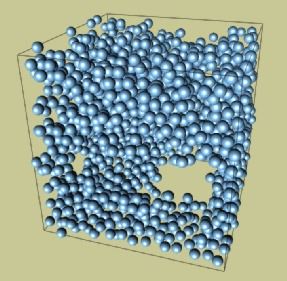Cluster of an isotropic 3D random fractal system of
1653 particles
The box extension is
18 sigma. The box in which the Lennard-Jones spheres are generated is
extended in all three dimensions by a factor of 3. From the 4050 particles
in the concatenated system (27x150 originally used by the
MD-procedure), 1653 are connected in the percolation cluster.

Frame taken from a video sequence showing motion of the seal of the
University Zurich the melting of
a fcc-crystal of 256 particles and a fly through the above shown 3D random
fractal.
Click on the picture to download the movie (MPEG: 8MBytes)
For more information see:
Fractals in isotropic systems generated with
attracting spheres
Erich Stoll,
Christian
Stern, and
Peter
Stucki,Physica A
230 (1996) 11-18.
Fractals in isotropic systems generated with
attracting spheres
Erich Stoll,
Christian
Stern, and
Peter
Stucki, Helv. Phys. Acta, 69, Separanda 1 (1996) 21-22.
A User Project: System Architecture for Parallel Particle Simulation in
Real-Time: Model Calculation and Visualization in Molecular Dynamics
Erich Stoll,
Christian
Stern, and
Peter
Stucki,
CrosSCutS,6,
#1, 26 (1997).
A toolkit for interactive molecular dynamics simulation and visualization
Christian
Stern,
Peter
Stucki, and
Erich Stoll, Nuclear Instruments and Methods in
Physics Research Section A: Accelerators, Spectrometers, Detectors and
Associated Equipment 389(1-2) (1997) 69-71.
A fast cluster counting algorithm for percolation on and off
lattices
Erich Stoll,
Computer
Physics Communications, 109 (1998) 1-5.
A new
filtering algorithm for medical MR- and CT- images
Erich Stoll,
Christian
Stern, Peter
Stucki, and Simon Wildermuth,
Journal of Digital Imaging, 12, #1, 23 (1999).
Parallel random number generator for inexpensive configurable hardware
cells
J. Ackermann, U.
Tangen, B. Bödekker, J. Breyer, E.
Stoll, and J.S. McCaskill, Computer
Physics Communications, Vol.
140 (3) (2001) pp. 293-302
For more information about videos and
pictures of moleculesclick here. They are simulated with the
MOLCAD-package
at the Department of Physical
Chemistry of the Darmstadt University of Technology
(THD).

